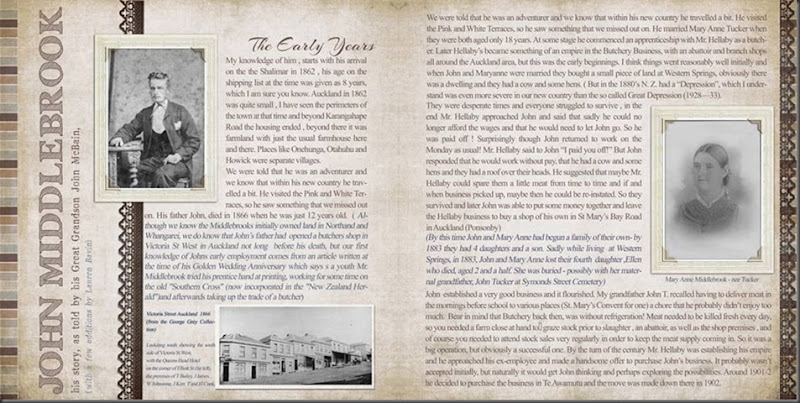His Story, as told by his Great Grandson with additions by me
I have to thank John McBain for his wonderful telling of this story, which he has written for me and emailed me in instalments. I decided that really there was no better way to tell the story of John Middlebrook than by using the words of his Great Grandson.
I have added a few facts that I discovered in my research which are in italics throughout the story. – This is the first instalment – the years before the family moved to Te Awamutu
JOHN MIDDLEBROOK – his story, as told by his Great Grandson John McBain ( with a few additions by Lauren Bavin
The Early Years
My knowledge of him , starts with his arrival on the the Shalimar in 1862 , his age on the shipping list at the time was given as 8 years, which I am sure you know. Auckland in 1862 was quite small , I have seen the perimeters of the town at that time and beyond Karangahape Road the housing ended , beyond there it was farmland with just the usual farmhouse here and there. Places like Onehunga, Otahuhu and Howick were separate villages.
We were told that he was an adventurer and we know that within his new country he travelled a bit. He visited the Pink and White Terraces, so he saw something that we missed out on. His father John, died in 1866 when he was just 12 years old. ( Although we know the Middlebrooks initially owned land in Northand and Whangarei, we do know that John’s father had opened a butchers shop in Victoria St West in Auckland not long before his death, but our first knowledge of Johns early employment comes from an article written at the time of his Golden Wedding Anniversary which says s a youth Mr. Middlebrook tried his prentice hand at printing, working for some time on the old "Southern Cross" (now incorporated in the "New Zealand Herald" and afterwards taking up the trade of a butcher)
and afterwards taking up the trade of a butcher)
We were told that he was an adventurer and we know that within his new country he travelled a bit. He visited the Pink and White Terraces, so he saw something that we missed out on. He married Mary Anne Tucker when they were both aged only 18 years. At some stage he commenced an apprenticeship with Mr. Hellaby as a butcher. Later Hellaby’s became something of an empire in the Butchery Business, with an abattoir and branch shops all around the Auckland area, but this was the early beginnings. I think things went reasonably well initially and when John and Maryanne were married they bought a small piece of land at Western Springs, obviously there was a dwelling and they had a cow and some hens. ( But in the 1880’s N. Z. had a “Depression”, which I understand was even more severe in our new country than the so called Great Depression (1928—33).
They were desperate times and everyone struggled to survive , in the end Mr. Hellaby approached John and said that sadly he could no longer afford the wages and that he would need to let John go. So he was paid off ! Surprisingly though John returned to work on the Monday as usual! Mr. Hellaby said to John “I paid you off!” But John responded that he would work without pay, that he had a cow and some hens and they had a roof over their heads. He suggested that maybe Mr. Hellaby could spare them a little meat from time to time and if and when business picked up, maybe then he could be re-instated.So they survived and later John was able to put some money together and leave the Hellaby business to buy a shop of his own in St Mary’s Bay Road in Auckland (Ponsonby)
(By this time John and Mary Anne had begun a family of their own- by 1883 they had 4 daughters and a son. Sadly while living at Western Springs, in 1883, John and Mary Anne lost their fourth daughter ,Ellen who died, aged 2 and a half. She was buried - probably with her maternal grandfather, at Symonds Street Cemetery)
John established a very good business and it flourished. My grandfather John T. recalled having to deliver meat in the mornings before school to various places (St. Mary’s Convent for one) a chore that he probably didn’t enjoy too much. Bear in mind that Butchery back then, was without refrigeration! Meat needed to be killed fresh every day, so you needed a farm close at hand to* graze stock prior to slaughter , an abattoir, as well as the shop premises , and of course you needed to attend stock sales very regularly in order to keep the meat supply coming in. So it was a big operation, but obviously a successful one. By the turn of the century Mr. Hellaby was establishing his empire and he approached his ex-employee and made a handsome offer to purchase John’s business. It probably wasn’t accepted initially, but naturally it would get John thinking and perhaps exploring the possibilities. Around 1901-2 he decided to purchase the business in Te Awamutu and the move was made down there in 1902.


No comments:
Post a Comment